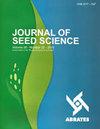海绵状Handroanthus spongiosus (Rizzini) S. Grose (Bignoniaceae)种子的保存与生理品质
IF 1.2
4区 农林科学
Q3 AGRONOMY
引用次数: 1
摘要
摘要:Handroanthus spongiosus (Rizzini) S. Grose是一种濒危树种。然而,其种子质量、储存和保护策略仍是尚未探索的问题。研究了海棉种子在不同贮藏时间、不同包装和不同保存环境下的生理品质。采用完全随机试验设计,采用双因子安排,并进行额外处理(最近收获的种子),包括5次储存时间(长达24个月)和6种储存条件,包括包装类型(透水和不透水)和环境(室内、冷藏室、冷冻室和液氮条件)。评价种子发芽率、正常苗率、茎长、根长、根冠干重比。室内保存的海棉种子的发芽率和正常成苗率随着保存时间的延长而降低。正常幼苗百分比从储藏12个月开始下降。由于低温和超低温不影响海棉幼苗的生长,建议在中短期保存海棉种子。本文章由计算机程序翻译,如有差异,请以英文原文为准。
Conservation and physiological quality of Handroanthus spongiosus (Rizzini) S. Grose (Bignoniaceae) seeds
Abstract: Handroanthus spongiosus (Rizzini) S. Grose is an endangered tree species. However, its seed quality, storage, and conservation strategies are issues still unexplored. This study aimed to evaluate the physiological quality of H. spongiosus seeds subjected to different storage times, packaging, and environments for their conservation. A completely randomized experimental design was used, in a double factorial arrangement with an additional treatment (recently-harvested seeds), consisted of five storage times (up to 24 months) and six storage conditions, combining packaging types (permeable and impermeable) and environments (room, cold chamber, freezer, and liquid nitrogen conditions). Seed germination percentage and normal seedling percentage, shoot length, root length, and root to shoot dry weight ratio were evaluated. The seed germination and normal seedling percentages of H. spongiosus seeds conserved under room conditions decreased over the storage time. Normal seedling percentages decreased from the 12th month of storage onwards. Low and ultralow temperatures are recommended for short and medium-term conservation of H. spongiosus seeds, since they did not affect the growth of seedlings.
求助全文
通过发布文献求助,成功后即可免费获取论文全文。
去求助
来源期刊

Journal of Seed Science
Agricultural and Biological Sciences-Agronomy and Crop Science
CiteScore
2.00
自引率
30.00%
发文量
28
审稿时长
12 weeks
期刊介绍:
From 2017 the Journal of Seed Science (JSS) will circulate online version only.
Original scientific studies and communications, not yet published or submitted to another journal for publication and written in Portuguese or English, will be accepted for publication. For manuscripts submitted in English, the authors should provide an adequated version.
The SCIENTIFIC COMMUNICATION is a category of scientific manuscript which describes a technique, an equipment, new species or observations and surveys of limited results. It has the same scientific rigor as the “Scientific Articles” and the same value as a publication. The classification of a manuscript as a SCIENTIFIC COMMUNICATION is based on its content and scientific merit but it can be a preliminary study, simple and not definitive on a certain subject, with publication justified by its uniqueness and contribution to the area.
The Editorial Board of the JSS may invite leading authors of recognized reputation to compose specific Review Articles covering topics of their specialization that will convey to the scientific community the state-of-the-art knowledge related to the specific theme.
 求助内容:
求助内容: 应助结果提醒方式:
应助结果提醒方式:


